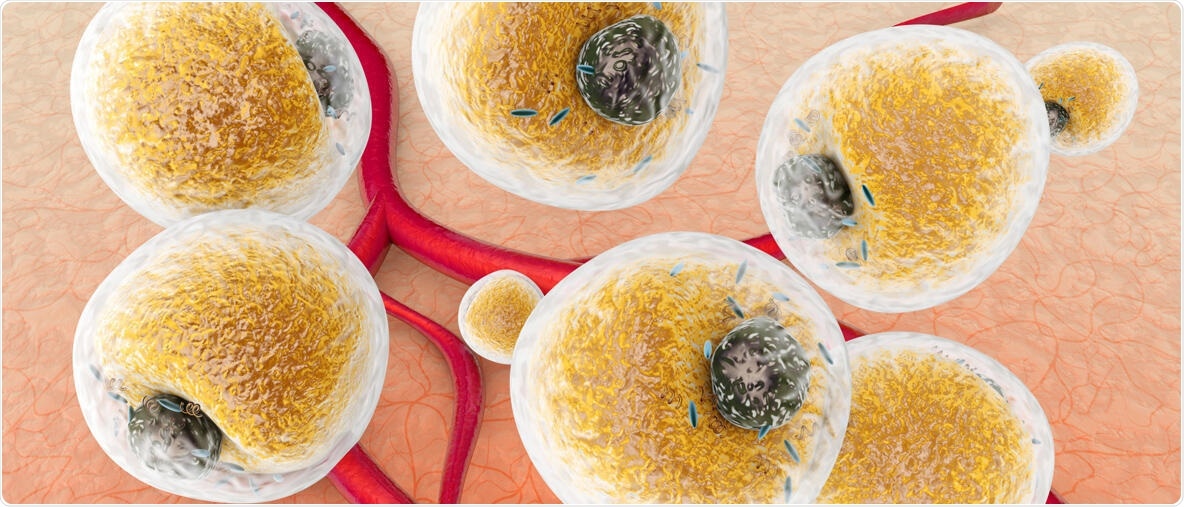The University of Helsinki has recently completed a twin study that suggests that the machinery responsible for handling the energy in fat tissues is performing poorly in obesity.

Obesity reduces mitochondrial gene expression in fat tissue. 3D rendered illustration of fat cells. Image Credit: University of Helsinki.
The study revealed a clear reduction in the activity of mitochondrial genes in the fat tissue, whereas an analogous genome-level modification in muscle mitochondria was insignificant. Only the mitochondria of fat tissue were linked to negative health effects.
Obesity clearly decreases the expression of mitochondrial genes in the adipose tissue, or fat tissue, discovered the researchers from the University of Helsinki’s Obesity Research Unit. Mitochondria are vital cellular powerhouses that process all the human’s energy intake. If the pathways involved in the nutrient breakdown are sluggish, the changes will usually have health-related implications.
The study conducted at the University of Helsinki included a total of 49 pairs of identical twins discordant for body weight: the metabolism and body composition of these twins were comprehensively analyzed and biopsies from muscle and adipose tissues were obtained. The study involved a number of techniques for studying genome-wide gene expression, the metabolome, and the proteome.
The findings were recently published in the Cell Reports Medicine journal.
According to the study results, obesity significantly decreases the pathways responsible for mitochondrial metabolism in fat tissues. Since mitochondria are crucial for the production of cellular energy, their decreased function can sustain obesity.
This is the first-ever study to compare the impact of obesity, particularly on the mitochondria in muscle tissue in the identical twin pairs: muscle mitochondria were also found to be out of tune, but the change was less pronounced than in the adipose tissue.
The study offered a clear connection between a pro-inflammatory condition and the low performance of fat tissue mitochondria. The results also suggested that metabolic changes in the fat tissue are linked to an increased buildup of fat in the liver, cholesterol, insulin metabolism disorders, and prediabetic glucose.
If mitochondria, the cellular powerplants, are compared to the engine of a car, you could say that the power output decreases as weight increases. A low-powered mitochondrial engine may also generate toxic exhaust fumes, which can cause a proinflammatory state in adipose tissue and, consequently, the onset of diseases associated with obesity.”
Kirsi Pietiläinen, Professor, Obesity Research Unit, University of Helsinki
“What was surprising was that the mitochondrial pathways in muscle had no association with these adverse health effects,” added Professor Pietiläinen.
Obesity also affected amino acid metabolism
During the analysis, changes in mitochondrial function were also observed in the metabolism of amino acids. In both muscle and adipose tissues, the metabolism of branched-chain amino acids, which are vital to human beings, was weakened in the mitochondria.
This finding was of particular significance because the reduced breakdown of these amino acids and the resulting heightened concentration in blood have also been directly linked with prediabetic changes and the accumulation of liver fat in prior twin studies.”
Kirsi Pietiläinen, Professor, Obesity Research Unit, University of Helsinki
Obesity, along with its various related disorders, is a common occurrence that has constantly become prevalent. Although lifestyle plays a role in the onset of obesity, genes also play a major role.
Identical twins have the same genes, and their weight is usually fairly similar. In fact, studying twins is the best way to investigate the interplay between genes and lifestyle. In spite of their identical genome, the genes and even mitochondria of twins can function on different activity levels. We utilized this characteristic in our study when looking into the effects of weight on tissue function.”
Kirsi Pietiläinen, Professor, Obesity Research Unit, University of Helsinki
Source:
Journal reference:
Van Der Kolk, B. W., et al. (2021) Molecular pathways behind acquired obesity: adipose tissue and skeletal muscle multiomics in monozygotic twin pairs discordant for BMI. Cell Reports Medicine. doi.org/10.1016/j.xcrm.2021.100226.